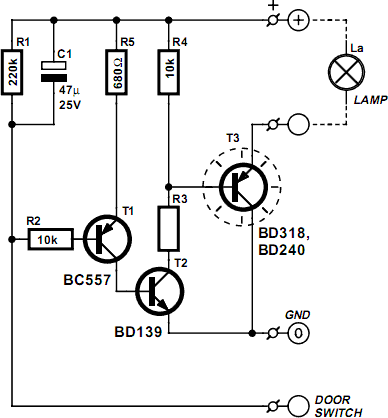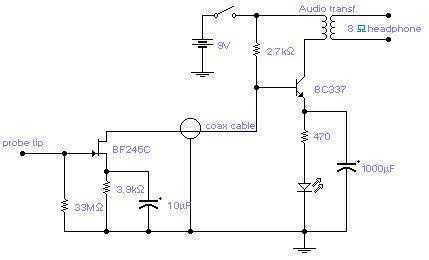
Light Detector

The circuit's threshold is determined by resistor R2. When the intensity of light on the LDR decreases, the resistance of the LDR increases, resulting in a lower voltage at the inverting input of the 741 operational amplifier. The reference voltage at the non-inverting input of the 741 is established through R2, allowing the comparator to switch from low to high when the light intensity on the LDR diminishes. This high output activates transistor Q1, which leads to the closure of the relay contacts.
The circuit utilizes a light-dependent resistor (LDR) to detect variations in light intensity. The LDR's resistance decreases with increasing light levels and increases in low-light conditions. Resistor R2 plays a critical role in setting the voltage threshold for the operational amplifier (op-amp) 741. When the light intensity drops below a certain level, the increase in LDR resistance results in a decrease in voltage at the inverting input of the op-amp.
The 741 op-amp functions as a comparator in this configuration. The non-inverting input is supplied with a reference voltage through R2, which is calibrated to define the threshold light level. When the voltage at the inverting input falls below this reference voltage, the op-amp output transitions from a low state to a high state. This transition is indicative of a condition where the ambient light has fallen below the predefined threshold.
Upon the output of the op-amp going high, it activates transistor Q1. The transistor acts as a switch, allowing current to flow through the relay coil. The relay contacts, which are normally open, close upon activation. This closure can be used to control various devices or systems, such as lighting or alarms, based on the light intensity detected by the LDR.
In summary, the circuit effectively monitors light levels and utilizes a comparator to control a relay based on the light intensity. The design is suitable for applications requiring automatic control in response to ambient lighting conditions, showcasing the versatility of op-amps and transistors in electronic control systems. The circuit"s threshold is set by resistor R2. When the intensity of the light falling on the LDR is lowered, resistance of that unit increases, and lowers the voltage applied to the inverting input of the 741. The reference voltage at the noninverting input of the 741 is set (via R2) so that the comparator switches from low to high when the light falling on the LDR is reduced. That high activates transistor Ql, which causes the relay contacts to close.
The circuit utilizes a light-dependent resistor (LDR) to detect variations in light intensity. The LDR's resistance decreases with increasing light levels and increases in low-light conditions. Resistor R2 plays a critical role in setting the voltage threshold for the operational amplifier (op-amp) 741. When the light intensity drops below a certain level, the increase in LDR resistance results in a decrease in voltage at the inverting input of the op-amp.
The 741 op-amp functions as a comparator in this configuration. The non-inverting input is supplied with a reference voltage through R2, which is calibrated to define the threshold light level. When the voltage at the inverting input falls below this reference voltage, the op-amp output transitions from a low state to a high state. This transition is indicative of a condition where the ambient light has fallen below the predefined threshold.
Upon the output of the op-amp going high, it activates transistor Q1. The transistor acts as a switch, allowing current to flow through the relay coil. The relay contacts, which are normally open, close upon activation. This closure can be used to control various devices or systems, such as lighting or alarms, based on the light intensity detected by the LDR.
In summary, the circuit effectively monitors light levels and utilizes a comparator to control a relay based on the light intensity. The design is suitable for applications requiring automatic control in response to ambient lighting conditions, showcasing the versatility of op-amps and transistors in electronic control systems. The circuit"s threshold is set by resistor R2. When the intensity of the light falling on the LDR is lowered, resistance of that unit increases, and lowers the voltage applied to the inverting input of the 741. The reference voltage at the noninverting input of the 741 is set (via R2) so that the comparator switches from low to high when the light falling on the LDR is reduced. That high activates transistor Ql, which causes the relay contacts to close.





